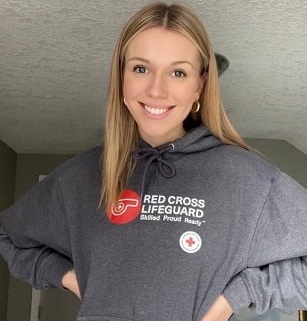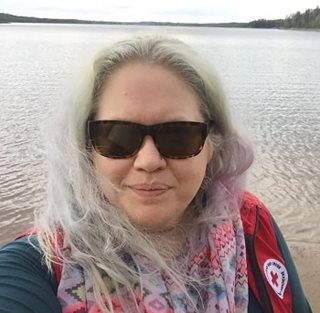Kailee Berezowski is a program coordinator for the Canadian Red Cross Indigenous Swimming and Water Safety program in Alberta. She says the pandemic provided opportunities for program instructors to innovate and expand delivery of water safety and injury prevention courses in Indigenous communities.
 “It created an opportunity and new goal for the team to reach and support more communities. 2021 is the first year that courses are being offered throughout the year, instead of just May through August as it was originally,” Kailee explains, pictured right. “Courses like Babysitting and Stay Safe courses along with other presentations and micro-sessions are available through winter.”
“It created an opportunity and new goal for the team to reach and support more communities. 2021 is the first year that courses are being offered throughout the year, instead of just May through August as it was originally,” Kailee explains, pictured right. “Courses like Babysitting and Stay Safe courses along with other presentations and micro-sessions are available through winter.”During the pandemic, program instructors could explore an identify additional needs within the community.
“It allowed us to reach more youth and to think outside of the box to ensure we could keep participants engaged by creating different interactive activities with our virtual courses,” she says. “In some ways, it enhanced our quality.”
Manager of Injury Prevention, Lesley-Anne Morley started the Indigenous Swimming and Water Safety program in Alberta in 2013. She continues to oversee its expansion to other provinces and territories like British Columbia, Saskatchewan, Manitoba, and Nunavut.
 According to Lesley-Anne (pictured left), Alberta has led the way and that includes adapting to virtual programming. The Red Cross is now able to offer courses virtually, in-person, self directed by the community or as a blended model.
According to Lesley-Anne (pictured left), Alberta has led the way and that includes adapting to virtual programming. The Red Cross is now able to offer courses virtually, in-person, self directed by the community or as a blended model.She says, “This year we offered a new course called Body Games. It offers dry-land water safety activities and includes a dry-land swim meet. So, it is a virtual physical activity that helps enhance swimming skills. It can be taught virtually, in-person or self-directed by the community. We are also offering basic First Aid for youth.”
Most of the content for the virtual courses created, and adapted in 2020, stayed the same in 2021, but the way they were presented has continued to evolve. Instructors added new interactive activities and platforms to increase participant engagement.
Each province and territory use different courses based on specific community needs. In 2021, for example, Red Cross offered a youth leadership course to participants in Inuvik.
“The more we share the knowledge and stories of the communities, the more we learn from one another, which is an amazing thing!’’ Kailee says. “The program is an amazing opportunity, and the impact is huge.”
The Indigenous Swimming and Water Safety program depends on grants, corporate sponsors, and donations. Lesley-Anne hopes to continue expanding the program in the provinces and territories in 2022.
Indigenous communities in Alberta and across Canada interested in prevention, safety and risk reduction programming can contact LesleyAnne.Morley@redcross.ca. Find more information on all courses offered by the Canadian Red Cross.
Related stories:

